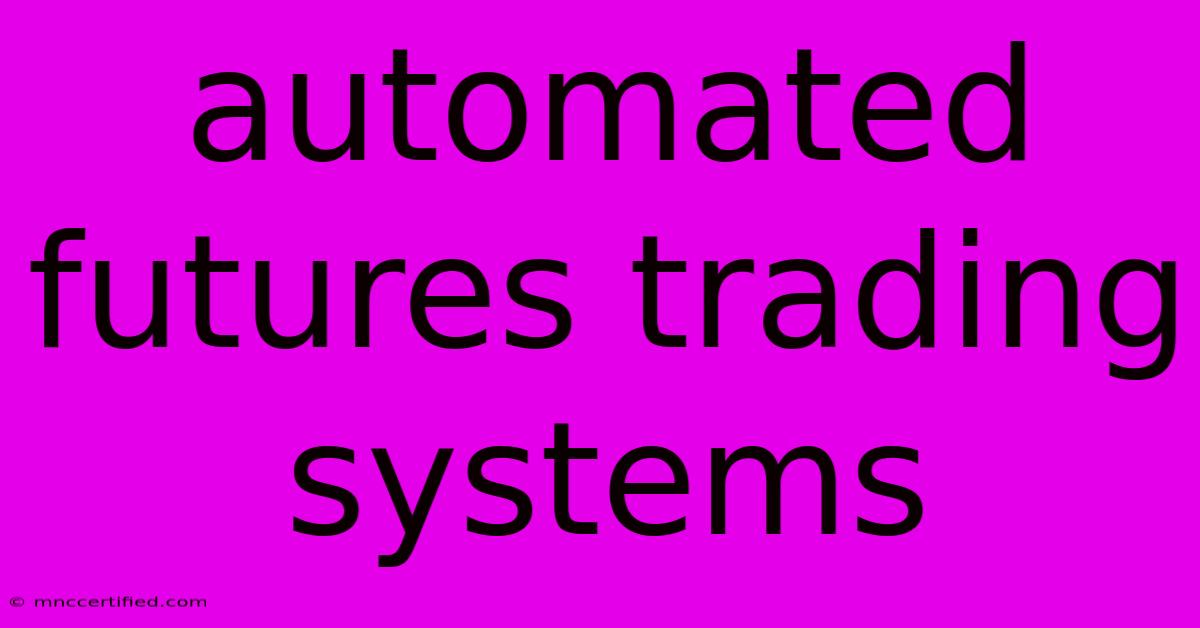Automated Futures Trading Systems

Table of Contents
Automated Futures Trading Systems: A Comprehensive Guide
The world of futures trading is dynamic and demanding, requiring lightning-fast decisions and constant market monitoring. This is where automated futures trading systems, also known as algorithmic trading systems or bots, come into play. These systems leverage sophisticated algorithms to execute trades automatically, based on predefined parameters and market conditions. This guide delves into the intricacies of these systems, exploring their advantages, disadvantages, and essential considerations for successful implementation.
Understanding Automated Futures Trading Systems
Automated futures trading systems use computer programs to analyze market data, identify trading opportunities, and execute trades without human intervention. These systems can react to market changes far faster than any human trader, potentially capitalizing on fleeting opportunities and minimizing risk. The core components typically include:
- Data Acquisition: Gathering real-time market data from various sources, including exchanges and market data providers.
- Signal Generation: Employing algorithms (e.g., moving averages, RSI, MACD) to analyze data and generate buy/sell signals.
- Order Management: Transmitting orders to the exchange, managing open positions, and handling risk management protocols.
- Backtesting & Optimization: Evaluating the system's performance using historical data to identify weaknesses and refine strategies.
- Monitoring & Reporting: Tracking the system's performance in real-time, generating reports, and providing alerts.
Advantages of Automated Futures Trading Systems
- Speed & Efficiency: Automated systems execute trades at speeds impossible for humans, capitalizing on fleeting market opportunities.
- Objectivity & Discipline: Eliminates emotional biases that can cloud judgment and lead to impulsive trading decisions.
- 24/7 Operation: Systems can trade continuously, monitoring markets around the clock, unlike human traders.
- Scalability: Easily handle large trading volumes and multiple markets simultaneously.
- Backtesting Capabilities: Allows thorough evaluation of strategies using historical data, minimizing risks before live trading.
Disadvantages of Automated Futures Trading Systems
- Complexity: Developing and maintaining sophisticated trading systems requires significant technical expertise and programming skills.
- Initial Investment: Developing and implementing these systems can be costly, involving software development, hardware, and data subscriptions.
- Risk of Errors: Bugs in the code or unexpected market events can lead to substantial losses if not properly managed.
- Over-optimization: Backtesting can lead to over-optimized strategies that perform poorly in live trading due to data snooping bias.
- Dependence on Data Quality: The accuracy and reliability of trading decisions depend heavily on the quality of the input data.
Essential Considerations for Implementing Automated Futures Trading Systems
- Choosing the Right Broker: Select a broker that supports automated trading and offers robust API access. Consider factors like commission fees, data feeds, and platform stability.
- Developing a Robust Strategy: Thorough research and backtesting are crucial to ensure the viability of your trading strategy. Consider factors like risk management, position sizing, and stop-loss orders.
- Risk Management: Implement strict risk management rules to protect against significant losses. This includes setting stop-loss orders, position sizing limits, and diversification strategies.
- Monitoring and Maintenance: Regularly monitor the system's performance, identify potential issues, and update the software as needed. This is crucial for adapting to changing market conditions.
- Security: Protect your trading system from unauthorized access and cyber threats through strong passwords, encryption, and regular security updates.
Types of Automated Futures Trading Systems
Several approaches exist for automating futures trading, each with its own advantages and disadvantages:
- Expert Advisors (EAs): Popular in the forex market, EAs are programs that run within a trading platform and execute trades based on predefined rules.
- Custom-built Systems: These offer greater flexibility and customization but require significant programming expertise.
- Cloud-based Platforms: These platforms provide pre-built trading tools and infrastructure, simplifying the development and deployment process.
Conclusion: Embracing the Future of Futures Trading
Automated futures trading systems offer significant advantages for experienced traders seeking efficiency, objectivity, and scalability. However, it's crucial to acknowledge the inherent complexities and risks involved. Careful planning, thorough testing, robust risk management, and continuous monitoring are essential for success in this field. By understanding the nuances of these systems and approaching implementation strategically, traders can leverage the power of automation to enhance their trading strategies and potentially achieve greater success in the dynamic world of futures trading. Remember to always consult with a financial advisor before making any investment decisions.

Thank you for visiting our website wich cover about Automated Futures Trading Systems. We hope the information provided has been useful to you. Feel free to contact us if you have any questions or need further assistance. See you next time and dont miss to bookmark.
Featured Posts
-
Argentina Vs Peru Live Stream Fifa 2026
Nov 20, 2024
-
Shelter Insurance Poplar Bluff Mo
Nov 20, 2024
-
Dwp Cold Weather Payment First Postcodes
Nov 20, 2024
-
Chip And Dale Disney Trading Pins
Nov 20, 2024
-
Fifa 2026 Argentina Vs Peru Live Stream
Nov 20, 2024